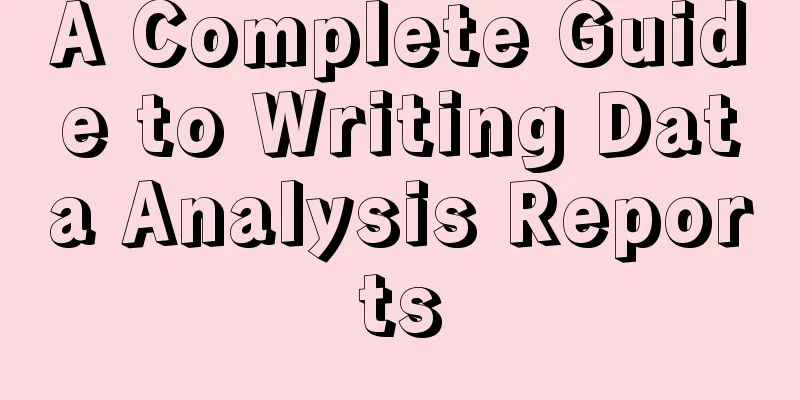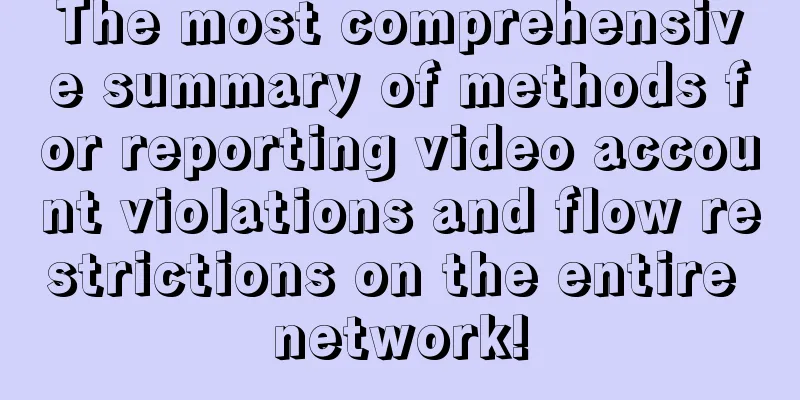A Complete Guide to Writing Data Analysis Reports

In the middle of the year, everyone is writing various reports. In theory, writing data analysis reports is the most basic skill of data analysts, and everyone should be able to do it. The scary thing is that no one reads the work you have worked so hard on! It’s still good if no one reads it, but what’s more scary is—— I guess every student who works with data or wants to work with data has seen similar statements: The data analysis report is divided into six steps:
The problem started from here. This cancer has misled countless newcomers. 1. Wrong posture of data analysis reportThe reason why this thing is a cancer is that it uses a 6-point style that seriously interferes with people's vision, forming an illusion that these 6 things are in the order of 1-6 and the workload is the same. In fact, in real corporate work, their relationship should be: Why is it so popular despite being a cancer? An interesting truth is that general education and training institutions sell Hadoop, BI, and Python courses separately. In the past two years, Python has been the main selling point, so data governance is rarely mentioned. Secondly, what newcomers like most is not the basic work of moving bricks, but the model! It is best to have an artificial intelligence model! ! So the two parties hit it off immediately. The educational institution prepared a data set, and the newcomers typed in the model code according to the example, ran it, and experienced the pleasure of mastering the artificial intelligence model. Everyone was extremely satisfied, except for those who read the report who were depressed: This is also an analysis? If you want to break through, you have to return to real work. Due to the limited space of this article, I will not talk about infrastructure construction first, but focus on discussing: how to discover the real issues that companies care about from data and make valuable reports. 2. The Nature of Data Analysis ReportsData analysis reports are essentially reports. The so-called reporters are people who speak and people who listen, thus forming two basic reporting modes: When making a report, the first step is to confirm what mode the report is in, including:
Don’t laugh! Many students can’t even do this basic task. They just mechanically and numbly fill in the data according to the template. Then he gathered all his strength and wrote in big letters: "This month's month-on-month increase of 2%". Then he sent it to the same group as the last email recipient. He even called it a daily report. As for what was reported? To whom? What was said? I have no idea. This kind of daily report is a waste of energy. It is better to just build a dashboard and let anyone who wants to see it see it. 3. How to write a listening reportI said that listening to reports seems to be the simplest, but if you want to do it well, you need to meet two conditions:
These two points seem simple, but they are actually troublesome. For example, the following figure: Many data analysts will only write:
The bold ones will also write:
However, a decline does not represent a problem. It is very likely that the business trend is just like this (as shown in the figure below). This situation is called: judging without fixed standards. Without clear KPIs, indicator requirements, and leadership orders. To make a "problematic" judgment, you need to consider multiple factors such as development trends, growth momentum, and industry environment. In fact, a lot of complex analysis is needed before writing a report. It is relatively easier to judge with fixed standards. For example, if the KPI for this month is 550, but the actual achievement is 500, then there is something wrong with this month. However, it is very likely that this is a tactical arrangement of the business (as shown below). Therefore, even if there are fixed standards, you still need to understand the business tactics and business strategy to make the right judgment. Making a judgment is only the first step. The second step, “telling others what they don’t know,” is more difficult. If the indicators are not met, it is just a number for the data analyst, but for the business department, they will be severely scolded, have their bonuses deducted, and even be fired. Therefore, the business department is also very sensitive to problems. If you just keep on talking about things like, "This month's performance is not good, and it has been bad for three consecutive months," you will definitely be criticized, "You are like a mourning bird, can you say something useful!!!" What you need to do at this time is to understand: how much do you know about the business? Students often complain that the business already knows the problem and there is nothing to write about. Note that what everyone knows here is just a result. As for why this result occurred and what will happen in the future, no one dares to guarantee that I know it clearly (as shown in the following picture). This is an opportunity for analysis. Some students may say: We cannot analyze so many things based on this table. Nonsense, of course there is no way to analyze it. This is actually taking the problem a step further. From the superficial: "The indicators are not met" to "What should I do to turn the situation around" to "There is a deeper problem here that you have not noticed". These are the truly valuable, in-depth areas that require professional analysis. The core of business strategy is to prioritize and make choices. The real value of data analysis lies in precise calculations and dealing with uncertainties. If performance indicators were like a car speedometer, which would increase when you stepped on the accelerator and decrease when you stepped on the brake, what else would need to be analyzed? Look, if there is a data analyst sitting in the passenger seat of a car, he will keep beeping all the way: "Your speed is 45 kilometers per hour, which is 5 kilometers higher than before", haha. In summary, I told you that the correct writing posture for listening reports is:
4. How to write a Q&A reportThe biggest pitfall of Q&A reports is the questions themselves. High-quality questions lead to high-quality answers; low-quality questions lead to poor analysis. Whether the questions are clear and accurate is one of the core skills in the workplace. There are too many topics to cover, so here we focus on data analysis issues. Please remember these five basic questions (as shown below). Note that only those who have been professionally trained can use these five sentences to describe the problem. Most people mix them together. For example, the leader said: "The conversion rate has dropped recently. I suspect that there are too many low-quality users. Let's see if it is caused by the recent promotion activities." This seems to be a problem, but if you break it down, you will find that there are actually a lot of problems hidden (as shown in the figure below). People are always easily influenced by recent events, popular discussions, and their own likes/dislikes. So what comes out of their mouths is often a feeling, a buzzword, or an attitude. The value of data analysis is to peel away the layers, go deeper and deeper, and separate the true from the false. The simpler the logic, the easier it is to verify. Therefore, when answering questions, it is very important to break down complex questions into simple ones and verify them layer by layer. Otherwise, it will always be a mess and nothing can be explained clearly. It is important to note that many business problems cannot be solved directly by data analysis, but require professional business capabilities. As an aid, we need to transform these business problems into actionable data analysis and then provide support (as shown below). Otherwise, firstly, our business capabilities may not be enough to give direct suggestions; secondly, we have already done the business work, so what is the point of business! ! (So cool! I can finally fight back with confidence). So when receiving questions, we need to clearly distinguish: what exactly is needed in the business? Is it data or a specific implementation plan that they lack? Providing professional advice within the scope of what we can do will have a good effect. In summary, the correct writing posture for a Q&A report is:
V. SummaryAfter watching the whole process, careful students will find that the process of making a report is actually the process of summarizing and generalizing Teacher Chen’s numerous analytical methods. That's right! Because the report itself is the last step of data analysis. Only after doing a variety of specific analyses can you write a high-quality report. Therefore, a high-quality report is never copied from a template. Many students like to ask: Is there any good data analysis report template so I can copy/learn from it? The specific problems, business backgrounds, business action plans, and problem breakdowns are all different. The only things that can be copied between reports are PPT templates and Excel templates. If you expect to copy others, you will only end up with complaints like "What did you analyze?" Think carefully: What do I want to say? What problem do I want to address? Have I made it clear? This is the right way to make a good report. Author: Down-to-earth Teacher Chen Source: WeChat public account "Down-to-earth Teacher Chen" |
<<: Traffic Alchemy of AI Applications
Recommend
Innovation and diversified development of pharmacies in the new retail era
What problems will the new changes in pharmacies b...
What is the Weee certification registration process? Process Introduction
When doing cross-border business abroad, if electr...
How can I check the ranking of Wish Store? How long is the store review cycle?
As a world-renowned cross-border e-commerce platfo...
Some thoughts for May 2023!
This article is the author’s personal summary of o...
What are the advantages of doing business on Amazon in the United States? Is it easy to do?
Now many friends want to do Amazon, so everyone ne...
How to provide feasible suggestions for business when doing data analysis
This article uses a real-life case study of an Int...
9 small details of Xiaohongshu operation, recent experience of starting an account
What are the details and methods of operation when...
Alibaba International Station Logistics upgrades the order function of the mini program
Alibaba International Station Logistics Mini Progr...
Comments on 14 popular money-making projects
Faced with the numerous money-making projects shar...
Taobao's full introduction of WeChat Pay does not actually bring much growth, but it can attract some goodwill
Although the full introduction of WeChat Pay by Ta...
Will AI replace new media professionals? We wrote an article using ChatGPT
This article is divided into two parts. The first ...
It’s time for Xiaohongshu to focus on store broadcasting
This article deeply analyzes Xiaohongshu's new...
What are the Shopee operation skills?
There are many cross-border e-commerce platforms n...
How much traffic does wish require to place an order? How can I achieve this?
We have to first clarify a concept, that is, in mo...
A Guide to Hard-core Influencer Branding
The ultimate goal of establishing a brand is to ha...









